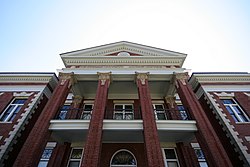Putnam County, Georgia | |
|---|---|
 Putnam County courthouse in Eatonton | |
 Location within the U.S. state of Georgia | |
 Georgia's location within the U.S. | |
| Coordinates: 33°19′N83°22′W / 33.32°N 83.37°W | |
| Country | |
| State | |
| Founded | December 10, 1807 |
| Named after | Israel Putnam |
| Seat | Eatonton |
| Largest city | Eatonton |
| Area | |
• Total | 361 sq mi (930 km2) |
| • Land | 345 sq mi (890 km2) |
| • Water | 16 sq mi (41 km2) 4.4% |
| Population (2020) | |
• Total | 22,047 |
| • Density | 64/sq mi (25/km2) |
| Time zone | UTC−5 (Eastern) |
| • Summer (DST) | UTC−4 (EDT) |
| Congressional district | 10th |
| Website | www |
Putnam County is a county located in the central portion of the U.S. state of Georgia. As of the 2020 United States census, the population was 22,047. [1] The county seat is Eatonton. [2]
Contents
- History
- Geography
- Major highways
- Adjacent counties
- National protected area
- Communities
- City
- Census-designated place
- Unincorporated community
- Demographics
- Education
- Politics
- See also
- Bibliography
- External links
Since the early 21st century, the county has had a housing boom. It has proximity to Lake Oconee, Lake Sinclair, and the Oconee River, all of which are recreation sites, as well as to major employment centers such as Atlanta, Athens, and Macon.
